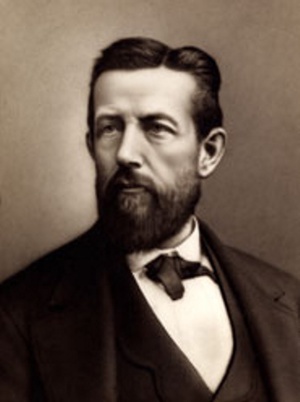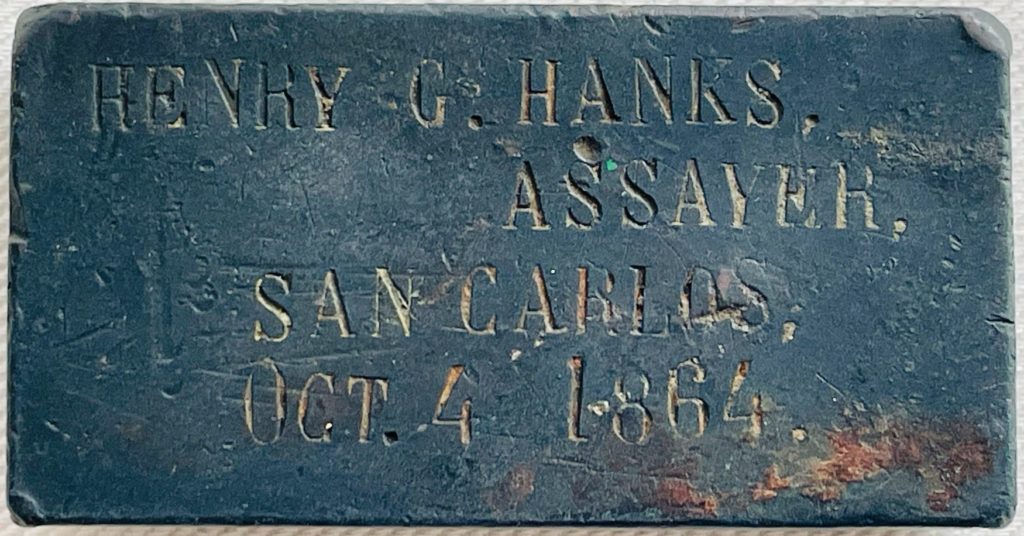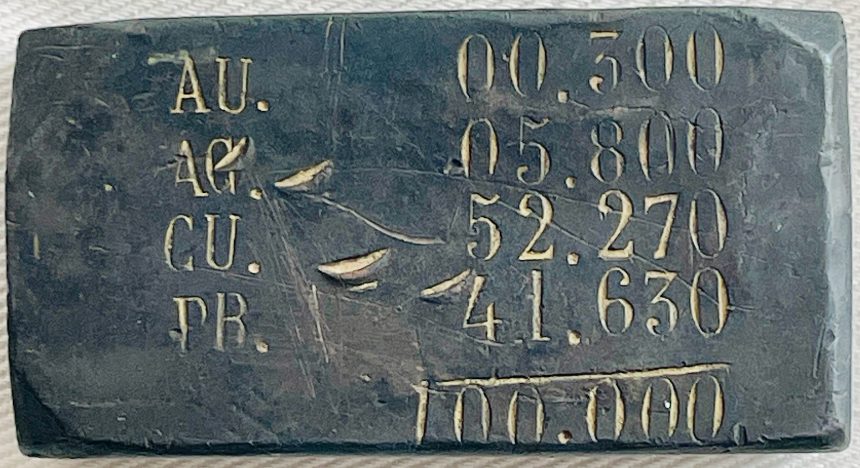Henry G. Hanks
Henry Garber Hanks was born in Cleveland, Ohio on May 12, 1826. He was borth to Jarvis Frary Hanks (portrait painter) and Charlotte Garber Hanks.
He worked in India in 1842 as a seaman for a year and came back to America where he travelled the states. By 1850 (US Census) he was living in Cleveland and working as a sign and house painter (probably with his father). From 1852 to 1856 he joined the Gold rush in California and worked in various mines in California and engaged in several businesses in Sacramento. By 1860 the San Francisco census shows him working as a painter as he had experience in this.

The State Assay Office in San Francisco was owned by Louis Falkenau and HW Reese. It was located in the Safe Deposit Building, Room 16, SE Corner of California and Montgomery Streets. Falkenau was an assayer in San Francisco opening their own company at the Pacific Chemical Works with Henry Hanks in the mid 1860’s (c1866). Later in the mid 1870’s he partnered with Henry W. Reese. Mr. Falkenau continued well into the first decade of the 20th century being the California State Assayer for a number of years. Thus Hanks and Falkenau would go on to serve major roles in the state as State Mineralogist & Assayers – below!
In 1867, Hanks married Ellen Francis Barker. They had five children. One of his children Abbott joined Hanks’s company as an assayer.
Hanks also founded the Microscopical Society of San Francisco (1872) and was its first president.
In 1878 Hanks was sent from California as mineral commissioner to the Paris Exposition.
In 1880 he was appointed California’s First State Mineralogist – a position he held until 1886. Under his guidance a museum and library were created.
On May 15, 1880, the Governor — under “An Act to provide for the establishment and maintenance of a Mining Bureau” — appointed Henry Hanks the State Mineralogist. Under this act, Hanks also reported directly to the Governor and as a result two new publications were created under his service, the Annual Report of the State Mineralogist series and Special Publication series. Prior to his appointment the State Legislature established the State Mining Bureau, which required the Bureau and the mineralogist to be located in San Francisco. Hanks started his own assaying company, Pacific Chemical Works, while in San Francisco.
Based in San Francisco, he was responsible for inspecting and classifying geological specimens submitted to the bureau, and for providing studies, annual reports, and various special publications. He was also responsible for the mineral exhibits of California and the United States at the 1884 New Orleans and 1893 Chicago World’s Fairs! Henry would have been present during the time when many famous and important ingots were shown in 1892.
He was founder of the Microscopical Society of San Francisco and was considered to have the finest mineral specimen collection in the city. [The Mineralogical Record: Biographical Archive].
Henry Hanks was once even a student of the famous Thomas Price – another well known assayer of which several ingots have survived.
On June 19, 1907, Hanks died in Alameda County, California.
William Letts Oliver
William Letts Oliver (August 6, 1844 – November 4, 1918) was a mining engineer who, along with Freeborn Fletter, founded the California Cap Company, the first U.S. manufacturer of blasting caps used for explosives in mining. He was also the principal owner of the Oliver Manufacturing Company.
Newspapers don’t have Letts coming to CA until late 60’s, but the ingot in this story may change the little history that we know of these two men below.
Letts was an avid entrepreneur and was involved in many companies and industries over the years. Some of those companies include:
- Black Bear Quartz Mining Company 1874, Secretary
- Eureka Mining Company, 1876
- Dardanells Consolidated Gravel Mining Company, 1877
- California Cap Co, 1880
The young Scotch mining engineer operating in Chile, undertook to manufacture collodion for tintype (dry-plate) pictures which he made as a hobby. For better or for worse this would tie him to the blasting cap factory/industry in the US later on in life. Guncotton is the basic raw material for the manufacture of collodion, and Oliver’s little factory thus grew into a small explosives factory which, in 1864, was taken over by the government of Chile. The government turned it into a munitions plant for making guncotton.
By 1877 in California he used that knowledge to help build the Sutro Tunnel in the Comstocks. Soon his new detonator was being manufactured which was safer to handle and superior in detonating than foreign imports. He incorporated the California Cap Co. for this purpose which is around to this day.
It still remains a mystery how Letts Oliver and Henry Hanks were tied in 1864, and more research is needed to clear up the questions we still have. Both figures led important roles in their time and for different reasons:
Henry Hanks as influential state mineralogist for California.
Letts Oliver for manufacturing safer blasting caps.
Hanks was the Assayer for San Carlos Company (see below)–perhaps Oliver had an influential role or ownership stake in the same company.
Henry G. Hanks Assayer, San Carlos, October 4, 1864, Oliver Letts, No 117, Hooper Inyo Ingot

Punched on all 6 sides, this is perhaps an ingot that history says should not exist. It has a low gold purity and were it not for its sheer beauty it would have been destroyed or melted long ago. What can only be described as a chalkboard-like surface with colored punches, this ingot is unlike any we have ever seen. Assay chips removed on two corners.

This is the only surviving ingot from Henry Hanks, the only ingot with ties to San Carlos and Inyo, and the only ingot with Oliver Letts. Furthermore, this is the only known ingot with such a high lead content with such a unique and stunning “jet black” look.
Top and bottom edges are inscribed with “OLIVER” and “LETTS OLIVER” – short for William Letts Oliver, the influential mining engineer with a background in photography and manufacturing of blasting powder.




Not marked for weight, but assayed for gold, silver, lead, and copper. The dollar value left as an exercise to the owner. This ingot was clearly not intended as a monetary one, but instead a true assay of what was mined within. The ultimate purpose was to show the purity of the elements in the ground and to guide the mining company on best course of action with respect to profitability.
- Face: HENRY G. HANKS, ASSAYER. SAN CARLOS, OCT 4 1864
- Back: AU. 00.300 // AG. 05.800 // CU. 52.270 // PB. 41.630 // —– // 100.000
- Top side: OLIVER
- Bottom side: LETTS OLIVER
- Left side: No 117
- Right side: HOOPER.INYO DIST.
Auction Appearances: None that we are aware of.
In 1862 a soldier stationed at Camp Independence, found some rich ore in the range of east of Independence which later developed into the San Carlos operation with considerable activity evidenced there the following year.
The San Carlos Exploring and Mining Company left San Francisco on Sept 24, 1862. They passed through the Yosemite Valley, traveled over Mono Trail, descended Bloody Cañon, crossed Adobe Meadows, and traveled down Owens Valley. The party arrived at the site of San Carlos on October 28, 1862. The group located the Hooper, Romelia, and Fleta veins. While camped at Lake Tenaya, the company named Cathedral Peak, which is now “a celebrated mountain.”
Thus “Hooper” refers to a vein in Inyo district (not yet a county) and was assayed by Henry G. Hanks. Letts Oliver may have had a role in the exploring and mining company at the time. (See: https://vredenburgh.org/mining_history/pdf/SanFranciscoBulletin.pdf, “Articles from the San Francisco Evening Bulletin”)
In fact, in Daily Alta California, 20 February 1864 it was reported as to how the Hooper vein was named – after a famous citizen of San Francisco, and it was one of 32 promising leads of the company:
The San Carlos Company intending resuming active operations the first of the coming week, erecting their mil–the machinery for which is all on the ground–as soon as practicable. When this work is done, the business of crushing the rock from the numerous leads of this company fully commenced, the effect upon the entire district will prove in the highest degree beneficial. In company with the Superintendent, I visited a number of the leads of this company which prospect rich in gold and silver. The leads embraced in this corporation are thirty-two in number, all of which, judging from the assays made, promise handsome returns when regularly worked. Among the titles of these lodes I noticed the familiar names of a number of well known citizens of San Francisco: the Middleton, the Woodward, Hooper, hanks, Rosenfield and others.
Daily Alta California, 20-02-1864, Volume 16, Number 5104.
The best part comes a little later in the article which directly ties Henry G. Hanks as the Assayer of the San Carlos Company!
… additions are constantly making to this place and Bend City–the rival claimants for the seat of Justice of the new county of Inyo, which, it is confidently anticipated, will be created by the present Legislature, if that measure, so essential to the convenience and welfare of the enterprising citizens of this region has not already passed the two Houses.
A number of pioneer citizens of the Valley who have sojourning for a season in San Francisco, have returned to the field of their labor–among them, Mr. H. G. Hanks, the Assayer of the San Carlos Company, who was warmly welcomed by his numerous friends in this quarter.
Daily Alta California, 20-02-1864, Volume 16, Number 5104
Four days after the ingot was made, on October 8, 1864 the Board of Trustees of the San Carlos Exploring and Mining Company held a meeting and created an assessment of Two Dollars per share (payable in gold coin) – levied on the capital stock of the company, payable on the 10th of October 1864. Clearly they made some executive decisions based on the assaying work of Henry G. Hanks, perhaps to go heavy into the Hooper vein! The report came in on the 5th of November in the Daily Alta California (Volume 16, Number 5360). For those not able to pay their dues, those shares would be sold as delinquent on the 24th of November.
Mineral Resources of the Country
Hanks has selected specimens of minerals from the area that he was lecturing on in the mid to late 1860s:
The minerals vary with the locality. At Esmeralda, the blue rock contains sulphurets of gold and silver. At Montgomery, argentiferous galena is found. It contains from 100 to 2,000 ounces of silver per ton; tetrahedrite and antimonial ores abound, but no gold. At Blind Spring, the ores contain partzite, galena, and antimonial ores and a complex mixture containing free silver. In the mountains behind Owensville, tetrahedrite and galena occur. With copper glance and gold-bearing quartz.
In Inyo and Russ districts are found galena, chrysocolla, cerusite, wulfenite, malachite, zinc blende, and gold-bearing quartz. At Cerro Gordo are found brown carbonates of lead, associated with galena, zinc blende, calc spar, and dolomite. At Alabama, the ores are worked only for free gold. All the copper ores carry a high percentage of gold. Some interesting combinations are found. Keragyrite, or silver chloride, is found. The main ore is [ ]. The rich ores of Montgomery, Kearsarge, Blind Springs, and Slate Range greatly resemble those of White Pine. Silver chloride and native silver are common.
Hanks is also showing several gold specimens. The metal is “quite abundant,” but unfortunately, is seldom free. Therefore, few of the ores can be treated by “the common amalgamating process.” Several “remarkably good mill runs” have been made on the decomposed surface ores, but there is little hope of successfully using those methods.
In the fall of 1864 the Kearsarge mine was discovered at a high elevation west of Independence and early work resulted in the disclosure of “jewelry rock.” In the central part of the valley Bend City and Chrysopolis were to join San Carlos to enjoy recognition in the mining world while ranchers and cattlemen, visualizing a ready market and homesteading opportunities, were to enter the valley in increasing numbers.
Inyo County was established on March 22, 1866 — formed out of the territory of the unorganized Coso County, which had been created on April 4, 1864 from parts of Mono and Tulare Counties. It acquired more territory from Mono County in 1870 and Kern County and San Bernardino County in 1872.
Named for the “dwelling place of the great spirit” in the Mono language, Inyo County has been the historic homeland for thousands of years of the Mono tribe, Coso people, Timbisha, and Kawaiisu Native Americans.
Bend City
In 1864, legislation was passed to create the State’s newest county. Everything was going as planned, all they needed was voter approval, which was successful. Nothing could stop them now…except for the fact they held the election on the wrong day. It nullified the entire legislation and the law was rewritten.

But rather than being called Coso, the new county was named Inyo. And unfortunately for Bend City, the honor of the new county seat was given to Independence. It was the beginning of the end for the local river towns. The mines were inefficiently operated and became cost prohibitive. San Carlos died, and Bend City was fading as its residents slowly relocate to Independence.
The final blow came in March of 1872 when the great Owens Valley earthquake hit. It was so powerful it changed the course of the Owens River away from Bend City. The Valley’s first major bridge now spanned a dry channel. (Ref: https://lawsmuseum.org/long-gone-river-towns-owens-valley)
We are extremely grateful to the collector who chose to share this gem with us and allowed us to showcase it on the website! We hope others will come forward with other unique and interesting “discovery” ingots and allow us to do a writeup on them as best we can.
